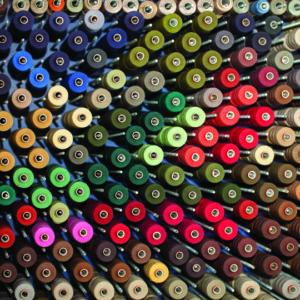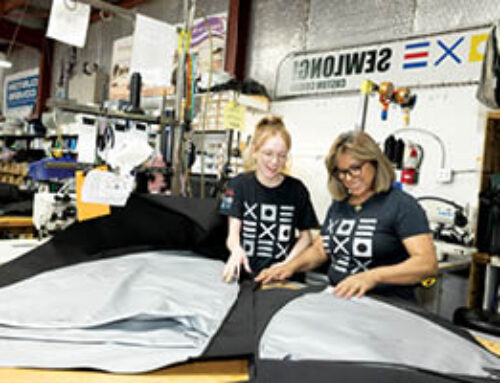New developments in marine thread

Photo: W.L. Gore
Improved, expanded options create happy customers and increase profits.
Now that sales of boats in the United States and around the world have been buoyed by the past two years of post-recession tides, marine fabricators have reason to smile.
Actually, make that multiple reasons, since recent developments in thread technology include increased UV resistance, lower prices, more sizes and expanded design options—all tools the savvy fabricator can use to create happy customers and increase profits.
Brighter days ahead
Take new colors, for example. “Marine vinyls are coming in brighter colors, which is leading to an increase in demand for matching and contrasting colors of thread,” observes Mike Sandercock of The Quality Thread & Notions Co. of Solon, Ohio, supplier of SolarFix® PTFE thread. Ditto, confirms Matt Grant, vice president and co-owner of supplier Sailrite Enterprises Inc. of Columbia City, Ind. Grant points out that although “Neutral colors of marine vinyls are still the most popular…within the past two years we have had more requests for bright colors ….”
Paralleling a trend toward bright colors in vinyl, Sandercock says, “One of the hottest new trends is sewing with a bold, contrast stitch,” noting the availability of different sizes in a variety of vibrant hues in SolarFix. True, agrees Aaron Stroud, who owns CanvasBarn Marine Trimming in Swan Reach, Victoria, Australia, and uses SolarFix. “We note that the new boats and jet skis that arrive in holiday periods have bright vinyls and contrasting stitching,” Stroud says. “We try to introduce contrasting stitching into our work where applicable; we think it looks fantastic in the right place.”
And he’s not the only fabricator who thinks so. “Many fabricators in the marine industries want bright, neon colors that withstand the outdoor element,” reports Richard Greenberg, owner and president of Vicar International Inc. of Union, N.J. That’s why Vicar introduced its 270 size Distinction-Poly T-277 UVR bonded polyester thread within the past year, making sure to offer it in such colors as lime green, red and forsythia (yellow) “for when seams need to be noticed.”
No wonder Sandercock reports that, “In the marine market, thread is becoming part of the design.”

A popular new development is polyester embroidery thread with improved UV resistance for use on projects with prolonged exposure to sunlight.
That’s a sentiment echoed by Bill McDaniel, marine market manager for Glen Raven Custom Fabrics, makers of Sunbrella. Although “Color choices for marine upholstery fabrics and contrast stitching tend to be more conservative,” McDaniel says, “we do see fabricators using contrasting colors in sewing threads and in bindings for cushions and seating applications.” One of those fabricators is Leo Pohlmann, owner of Uncharted Marine Canvas Inc. in Gulf Breeze, Fla. He finds that “the larger [Tenara] thread makes a great stitch look when you topstitch or french seam on cushions for outdoor use.”
But PTFE threads like Tenara and SolarFix aren’t the only options for accent stitching. Chris Ritsema, owner of Canvas Innovations in Holland, Mich., reports that in addition to using Tenara “on all our canvas products and with our upholstery—we have used Tenara on vinyl for some time—we do, however, use polyester threads as well, depending on color selection
and also depending on if embroidery is a part of the project.”
And for projects exposed to sunlight, polyester embroidery thread with improved UV resistance is another new development. “Vision” UV-stable embroidery thread was introduced about one year ago by Quality Thread & Notions.

Gore’s Tenara threads come in a variety of colors that produce the high-contrast that is becoming increasingly popular with boat owners.
Bigger size, smaller cost
As for that “larger thread” that Pohlmann sometimes uses for accent stitching, it’s HTR Tenara, introduced by Newark, Del.-based W.L. Gore & Associates Inc. in the fall of 2014. HTR is a heavyweight PTFE that Uncharted Marine Canvas uses for other applications besides accents, says Pohlmann. “We have mainly used it for heavier application on products such as catamaran trampolines, large awnings and enclosures [for which] we use 40-gauge Strataglass or polycarbonate panels.” The new size is cost-effective, too, points out Gore’s John Shaw. The fact that HTR Tenara provides 10 percent more yield per cone than the company’s previous HTR makes this thread comparatively less expensive, he says.
Sewability
Increased ease of handling is another advance that’s newly available, Shaw adds. “HTR is ‘rounder,’ so that increases its sewability,” he explains. “When compared with polyester, this type of thread is inherently stiff. However, we made it feel and handle more like polyester thread; in other words, more pliable.”
Pohlmann offers these tips for handling PTFE. He recalls that, “It took us a while to set up our sewing machines to sew with this type of thread…which created some initial challenges due to its slick characteristics. Gore’s website…has a processing guideline that’s very helpful for troubleshooting stitch quality and offers suggestions for thread size depending upon your project.” Another way to obtain guidance is to follow the recommendation of Quality Thread & Notions’ Sandercock to contact your thread supplier.

While neutral colors remain the most popular, fabricators say customers are increasingly requesting brightly colored fabrics and contrasting thread colors. Photo: W.L. Gore
It’s easy for marine fabricator Liz Diaz to quickly put her hand on the correct weight of thread she needs for a given project. Diaz, the owner of North Beach Marine Canvas in San Francisco, Calif., explains her system: “I labeled my machines [according to which size thread was on a particular sewing machine] and store the appropriate thread in the vicinity. Traditionally, I’ve used Tenara—for exterior canvas we use Tenara or SolarFix—but the SolarFix has a nice texture and I want to use more of it in the future.”
Riding the demographic wave
Diaz may find increasing opportunity to do exactly that. In fact, both these lifetime-warrantied PTFE threads may see increased customer demand, with fabricators finding that requests for SolarFix and Tenara start increasing significantly in about five years. That’s because 2020 is the year the millennial generation, born between 1980 and 2000, is predicted to enter its peak earning years. Given published marketing reports about the demographic group’s tendency toward value-driven purchasing decisions that consider environmental ramifications, products that include lifetime-warrantied PTFE thread may be perceived as less wasteful and hence more desirable than products sewn with less durable polyester thread, despite PTFE’s greater cost.
Uncharted Marine Canvas’ Pohlmann uses that perception to his advantage. “Using [this] thread is more costly than your regular polyester thread,” he says. “We used to ask the customer if they preferred [it] and would have an additional upcharge for this application. Now, we just add it to the job, but inform the customer about the value of the thread: will not sun rot; chemical resistant; will not fade; and has a lifetime warranty. The big advantage is that the customer will not have to have it re-stitched in three years like polyester thread.…We have all seen cushions come into our shop with blown-out seams because the thread has sun rotted or has deteriorated because of chemical cleaning of the vinyl upholstery. This makes a great opportunity to upsell the customer…the value to the customer is that he should never have this problem again if he uses the Tenara….”

At Gulf Breeze, Fla’s Uncharted Marine Canvas, owner Leo Pohlmann says he uses an upgraded thread and informs the customer about its added values: no sun rot; chemical resistance; no fading, and a lifetime warranty. Photo: W.L. Gore
Opportune environment
This type of fabricator-to-customer message may sound especially appealing to environmentally conscious millennials, according to Unity Marketing’s Feb. 5, 2015, online research report, “Millenials & Their Luxury Aspirations.” The oldest members of this demographic group turn 35 this year, thereby entering the traditional peak earning years of 35–54 that are expected to last through 2034. This year’s ushering in of millennials’ 20-year window of affluence is supported by a Feb. 22, 2015, report in the boating business news publication Trade Only Today that sales of powerboats in January 2015 were 10 percent ahead of last year.
Happily for marine fabricators, expanded thread options in UV resistance, lower prices, size and color are new tools that may help them meet the expectations of both current clients and increasingly important millennial customers.
Janet Cass is an editor and writer in St. Paul, Minn.
 TEXTILES.ORG
TEXTILES.ORG 






